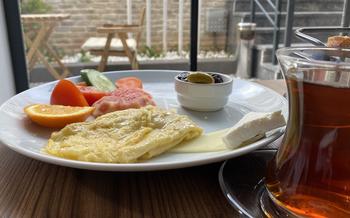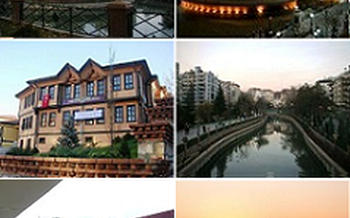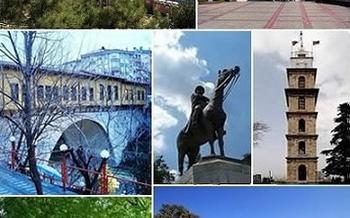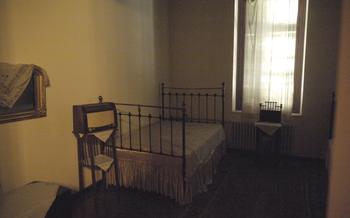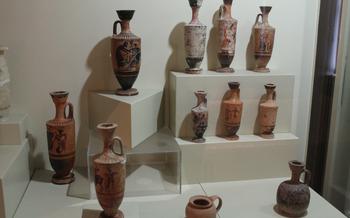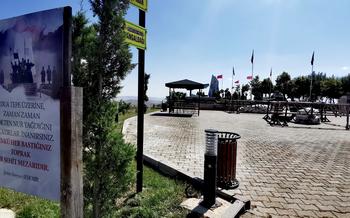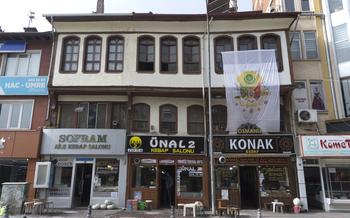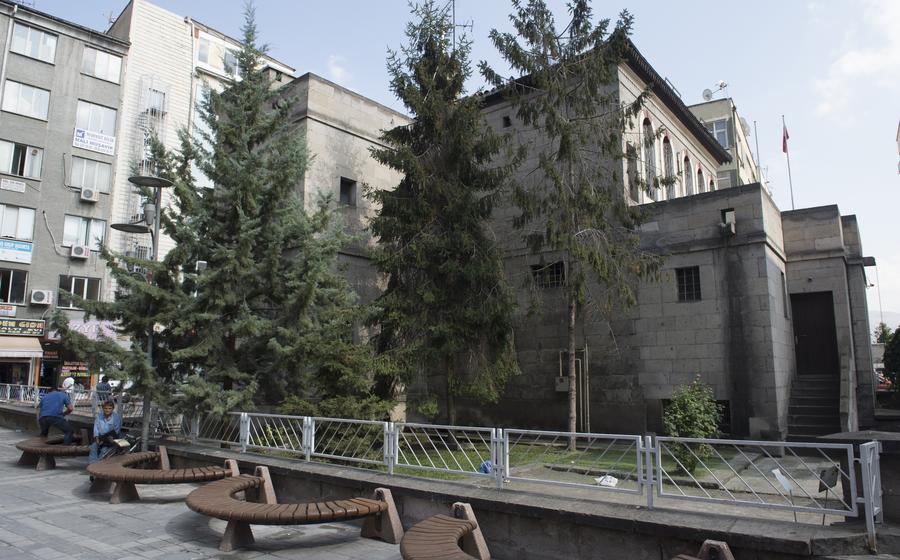
Atatürk House Museum
- Atatürk House Museum: A Glimpse into the Life of a Turkish Statesman
- Admission Fee and Operating Hours
- Exploring the Museum's Exhibits
- Atatürk's Connection to Kayseri
- Other Attractions Near the Museum
- Photography and Videography Guidelines
- Accessibility for Visitors with Disabilities
- Educational Programs and Workshops
- Souvenirs and Merchandise
- Local Customs and Etiquette
- Language Assistance and Translations
- Sustainability and Conservation Efforts
- Community Involvement and Outreach
- Insider Tip: Hidden Gems of the Museum
Atatürk House Museum: A Glimpse into the Life of a Turkish Statesman
The Atatürk House Museum, located in the heart of Kayseri, offers a fascinating glimpse into the life and legacy of Mustafa Kemal Atatürk, the founder of the Republic of Turkey. The museum occupies a historic building that once served as the Kayseri Municipality Building, where Atatürk resided during his visits to the city. The building's architectural style blends traditional Ottoman elements with modern influences, reflecting the transition Turkey underwent during Atatürk's era. Today, the museum stands as a testament to Atatürk's vision and leadership, showcasing his personal belongings, official documents, and memorabilia that shed light on his remarkable journey.
Admission Fee and Operating Hours
Current ticket price for domestic and international visitors:
- Domestic visitors: 10 TL
- International visitors: 15 TL
Discounts or free admission for certain groups:
- Students with valid student ID: 5 TL
- Children under 12 years old: Free
- Disabled visitors and their companions: Free
- Senior citizens over 65 years old: 5 TL
Opening and closing times of the museum:
- Summer (April-October): 8:30 am to 5:30 pm
- Winter (November-March): 8:30 am to 4:30 pm
Best time to visit to avoid crowds:
- The museum is typically busiest during the summer months and on weekends.
- To avoid crowds, it is recommended to visit during the weekdays or in the early morning or late afternoon.
Exploring the Museum's Exhibits
The Atatürk House Museum showcases a diverse collection of artifacts and personal belongings that offer insights into the life and accomplishments of Mustafa Kemal Atatürk. Visitors can explore various sections and rooms dedicated to different aspects of his life and legacy.
A highlight of the museum is the meticulously preserved study room, where Atatürk spent countless hours working and making important decisions. The room features his original desk, chair, and personal belongings, creating a sense of intimacy and connection with the great leader.
Interactive exhibits and multimedia presentations bring Atatürk's story to life. Visitors can watch historical footage, listen to his speeches, and engage with interactive displays that provide additional information and context.
The museum also houses a collection of photographs, documents, and personal items that shed light on Atatürk's military campaigns, political achievements, and his role in shaping modern Turkey. These exhibits offer a comprehensive understanding of his contributions to the nation's history and development.
Exploring the Atatürk House Museum is a journey through time, allowing visitors to connect with the legacy of a remarkable statesman and gain a deeper appreciation for his impact on Turkey and the world.
Atatürk's Connection to Kayseri
Mustafa Kemal Atatürk, the revered founder of the Turkish Republic, shared a special bond with the city of Kayseri. His first visit to Kayseri occurred in 1919, during the Turkish War of Independence, where he was warmly welcomed by the local population. Atatürk recognized the city's strategic importance and visited it several times during his presidency.
In 1923, Atatürk made a significant contribution to the city's development by establishing the Kayseri Sugar Factory, which played a crucial role in boosting the local economy and improving the livelihoods of its residents. He also initiated the construction of the Kayseri-Sivas railway line, connecting the city to other parts of the country and facilitating trade and transportation.
Atatürk's appreciation for Kayseri extended beyond its strategic significance. He was captivated by the city's rich cultural heritage, natural beauty, and the warmth of its people. Local stories and anecdotes recount his interactions with locals, his visits to historical sites, and his participation in traditional festivities, demonstrating his genuine fondness for the city.
Atatürk's influence on Kayseri's development is evident in the city's modern infrastructure, educational institutions, and cultural landmarks. His legacy continues to inspire the people of Kayseri, who hold him in high esteem and cherish the contributions he made to their city.
Other Attractions Near the Museum
In addition to the Atatürk House Museum, Kayseri offers a wealth of other attractions within walking distance. History enthusiasts will appreciate the Kayseri Castle, a 6th-century Byzantine fortress that still stands as a testament to the city's rich past. The castle offers panoramic views of the city and the surrounding Erciyes Mountain, making it an ideal spot for photography.
For those seeking a glimpse into Kayseri's religious heritage, the Ulu Mosque, built in the 12th century, is a must-see. This magnificent mosque is an architectural marvel, showcasing intricate tilework and Seljuk-style minarets. Visitors can marvel at the beauty of its interior, characterized by a spacious prayer hall and stunning calligraphy.
Nature lovers can escape the city's hustle and bustle at the nearby Erciyes Mountain, a popular destination for hiking, skiing, and mountain climbing. With its breathtaking scenery and diverse flora and fauna, Erciyes offers a rejuvenating experience for outdoor enthusiasts.
To create a comprehensive itinerary for Kayseri, consider combining your visit to the Atatürk House Museum with these other attractions. Allow for ample time to explore each site and immerse yourself in the city's rich history and natural beauty. Along the way, don't forget to savor the local cuisine at Kayseri's many restaurants and cafes, offering traditional Turkish dishes and delectable desserts.
Photography and Videography Guidelines
Respectful Photography: Capturing Memories at the Atatürk House Museum
Photography and videography are generally permitted within the Atatürk House Museum, allowing visitors to capture their memories and share their experiences. However, the museum has implemented certain guidelines to ensure the preservation of the exhibits and the privacy of other visitors.
Designated areas or restrictions for photography may exist in certain sections of the museum. These areas are typically marked with signs or indicated by museum staff. It is important to respect these restrictions and avoid using flash photography, which can damage delicate artifacts.
When taking photographs or videos, visitors are encouraged to be mindful of the other guests in the museum. It is considered polite to avoid blocking their view or disrupting their experience. Using a tripod or monopod may be restricted in some areas to prevent obstruction.
To capture the best shots of the museum's exhibits, visitors should consider using a wide-angle lens to capture the grandeur of the rooms and the intricate details of the artifacts. Natural light is often sufficient for photography, but additional lighting may be permitted in certain areas.
Visitors are reminded that the Atatürk House Museum is a place of historical significance and respect. Taking photographs or videos should not detract from the solemnity and reverence of the site. By following these guidelines, visitors can contribute to the preservation of this important cultural heritage while creating lasting memories of their visit.
Accessibility for Visitors with Disabilities
The Atatürk House Museum is committed to providing an accessible and inclusive environment for all visitors, regardless of their abilities. The museum's entrance is equipped with a ramp for wheelchair access, and there are elevators available to reach the upper floors of the building. Additionally, the museum provides wheelchairs for visitors who may need them, and staff members are always ready to assist with any accessibility needs.
Visitors with visual impairments can take advantage of the museum's audio guides, which are available in several languages. These guides provide detailed descriptions of the exhibits and the museum's history, allowing visitors to fully appreciate the museum's collection.
For visitors with hearing impairments, the museum offers sign language interpretation upon request. Visitors should contact the museum in advance to arrange for this service.
The Atatürk House Museum is dedicated to ensuring that all visitors have a positive and enriching experience, regardless of their abilities. With its accessible features and services, the museum welcomes visitors from all walks of life to explore the life and legacy of Mustafa Kemal Atatürk.
Educational Programs and Workshops
The Atatürk House Museum offers a range of educational programs and workshops designed to engage visitors of all ages and backgrounds. These programs aim to promote a deeper understanding of Atatürk's life, achievements, and the historical context of his time.
Educational Programs for Students:
- Guided tours tailored to school groups, providing interactive learning experiences and hands-on activities.
- Educational workshops on Turkish history, focusing on Atatürk's role in the country's development.
- Competitions and quizzes to encourage students to engage with the museum's exhibits.
Workshops for Adults and Families:
- Lectures and talks by historians and experts on Atatürk's life and legacy.
- Interactive workshops on Turkish culture, art, and music, inspired by Atatürk's vision of a modern Turkey.
- Family-friendly activities, such as storytelling sessions and crafts, to introduce children to Atatürk's contributions.
Prior Registration and Accessibility:
- Prior registration is required for educational programs and workshops to ensure proper planning and group size management.
- The museum provides materials and resources for educators and parents to facilitate learning.
- Accessibility features, such as ramps and elevators, are available for visitors with disabilities.
Enriching the Museum Experience:
- Educational programs and workshops offer a unique opportunity to delve deeper into the history of Turkey and Atatürk's life.
- Visitors can gain insights into the challenges and triumphs of the Turkish Republic's founding father.
- Engaging activities and interactive exhibits make learning fun and memorable for all ages.
Souvenirs and Merchandise
Within the premises of the Atatürk House Museum, visitors will find a well-stocked gift shop offering a diverse range of souvenirs and merchandise related to Atatürk and Turkish history. These items serve as mementos of your visit and make for thoughtful gifts for loved ones back home.
The gift shop features an array of products, including books, postcards, magnets, keychains, and replicas of historical artifacts. You can find items depicting Atatürk's image, quotes, or significant events from Turkish history. The quality of the merchandise is generally good, and the prices are reasonable, allowing visitors to purchase meaningful souvenirs without breaking the bank.
By purchasing souvenirs from the museum's gift shop, you not only take home a piece of Turkish history but also support local artisans and the museum itself. Your patronage contributes to the preservation and promotion of Atatürk's legacy and helps ensure that the museum continues to provide a valuable cultural experience for visitors from around the world.
Local Customs and Etiquette
When visiting the Atatürk House Museum, it is essential to be mindful of local customs and etiquette to show respect for Turkish culture and the memory of Atatürk. Visitors should dress modestly, avoiding revealing or overly casual clothing. It is customary to greet museum staff and fellow visitors with a polite "Merhaba" (Hello) and a slight nod of the head. Maintaining a respectful tone and avoiding loud or disruptive behavior is important. Refraining from touching or leaning on historical artifacts and exhibits is crucial to preserving the museum's heritage. Visitors should be aware of designated prayer areas within the museum and respect the privacy of those engaged in prayer. Photography and videography should be conducted with consideration and without disturbing other visitors. By observing local customs and etiquette, visitors can contribute to a positive and respectful atmosphere while exploring the Atatürk House Museum.
Language Assistance and Translations
The Atatürk House Museum recognizes the importance of making its exhibits and information accessible to visitors from diverse linguistic backgrounds. To facilitate a comprehensive understanding of the museum's content, multilingual audio guides are available for rent at the entrance. These guides provide detailed explanations and historical context in several widely spoken languages, ensuring that visitors can fully immerse themselves in the life and legacy of Atatürk.
For visitors who do not speak Turkish or English, the museum offers translation services upon request. Knowledgeable staff members or volunteers are available to assist with translations of signage, exhibits, and any inquiries visitors may have. This service ensures that everyone, regardless of their language proficiency, can engage with the museum's content and appreciate the significance of Atatürk's contributions.
The museum's website and informational brochures are also translated into several languages, making it easier for visitors to plan their visit and learn about the museum's exhibits before their arrival. By providing these language assistance services, the Atatürk House Museum strives to create an inclusive and welcoming environment for all visitors, fostering a deeper understanding and appreciation of Turkish history and culture.
Sustainability and Conservation Efforts
The Atatürk House Museum is committed to sustainability and conservation practices, recognizing the importance of preserving historical artifacts and minimizing environmental impact. The museum has implemented various initiatives to achieve these goals:
-
Energy Efficiency: The museum utilizes energy-efficient lighting, heating, and cooling systems to reduce energy consumption and decrease its carbon footprint.
-
Water Conservation: Water-saving measures, such as low-flow faucets and efficient landscaping, are in place to conserve water resources.
-
Waste Management: The museum actively promotes waste reduction and recycling programs to minimize waste production and contribute to a cleaner environment.
-
Eco-Friendly Materials: The museum strives to use eco-friendly and sustainable materials in its operations, including biodegradable cleaning products and recycled paper products.
-
Visitor Engagement: The museum engages visitors in responsible tourism practices through educational programs and signage that encourage sustainable behavior.
By implementing these initiatives, the Atatürk House Museum demonstrates its commitment to preserving its historical heritage while promoting environmental stewardship and sustainability.
Community Involvement and Outreach
The Atatürk House Museum is not merely a repository of historical artifacts but also a vibrant hub for cultural heritage and community engagement. Recognizing the importance of preserving and promoting Turkish history, the museum actively engages with the local community through a range of outreach programs, workshops, and events. These initiatives aim to foster a sense of pride and ownership among Kayseri's residents and create a deeper understanding of Atatürk's legacy and its significance for the city.
The museum collaborates with local schools, universities, and cultural organizations to develop educational programs that bring history to life for students of all ages. Through interactive workshops, lectures, and guided tours, young people learn about Atatürk's life, his contributions to Turkey's independence, and his enduring impact on the nation's development. These programs instill a sense of patriotism and encourage the younger generation to become active participants in preserving their cultural heritage.
The museum also hosts regular events that are open to the public, such as cultural exhibitions, film screenings, and historical reenactments. These events provide a platform for local artists, historians, and community members to showcase their talents and share their knowledge with a broader audience. By creating opportunities for dialogue and exchange, the museum fosters a sense of belonging and strengthens the bonds between the community and its rich history.
The Atatürk House Museum's commitment to community involvement and outreach extends beyond its physical walls. Through its educational initiatives and collaborations, the museum plays a vital role in promoting cultural heritage, preserving local traditions, and inspiring future generations to embrace their history with pride.
Insider Tip: Hidden Gems of the Museum
Beyond the main exhibits, the Atatürk House Museum holds a few hidden gems that are worth seeking out. One such gem is the small library on the second floor, which houses a collection of Atatürk's personal books, some of which contain his handwritten notes and annotations. Another hidden gem is the garden behind the house, which offers a tranquil retreat from the hustle and bustle of the city. Visitors can relax on a bench amidst the lush greenery and enjoy the peaceful atmosphere. For a unique photographic opportunity, head to the rooftop of the museum, which offers panoramic views of Kayseri and the surrounding mountains. To make the most of your visit, plan to spend a few hours exploring the museum, especially during the weekdays when it's less crowded. This will give you ample time to discover the hidden gems and immerse yourself in the life and legacy of Atatürk.
After your visit, consider exploring the nearby neighborhood of Talas, where you'll find a variety of local cafes and restaurants serving traditional Turkish cuisine. Indulge in a delicious meal and soak up the authentic atmosphere of this historic district.

